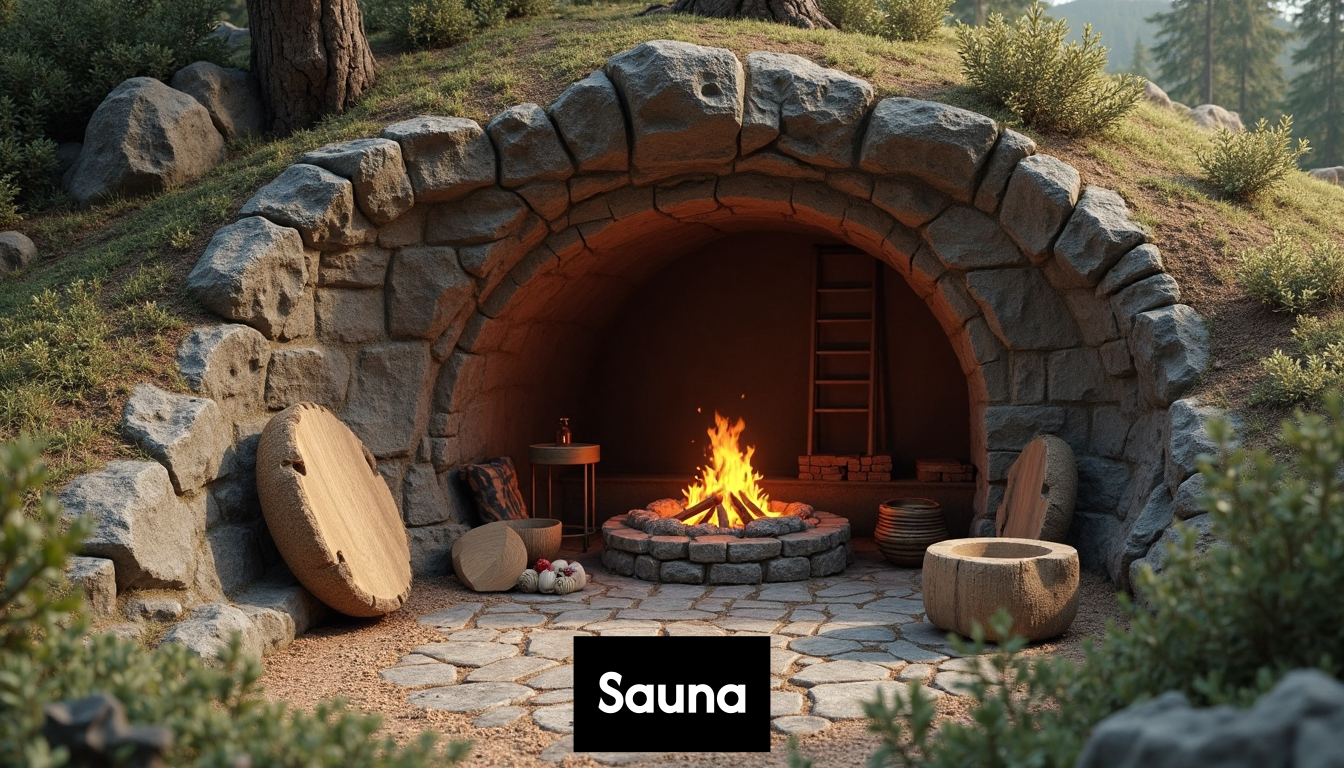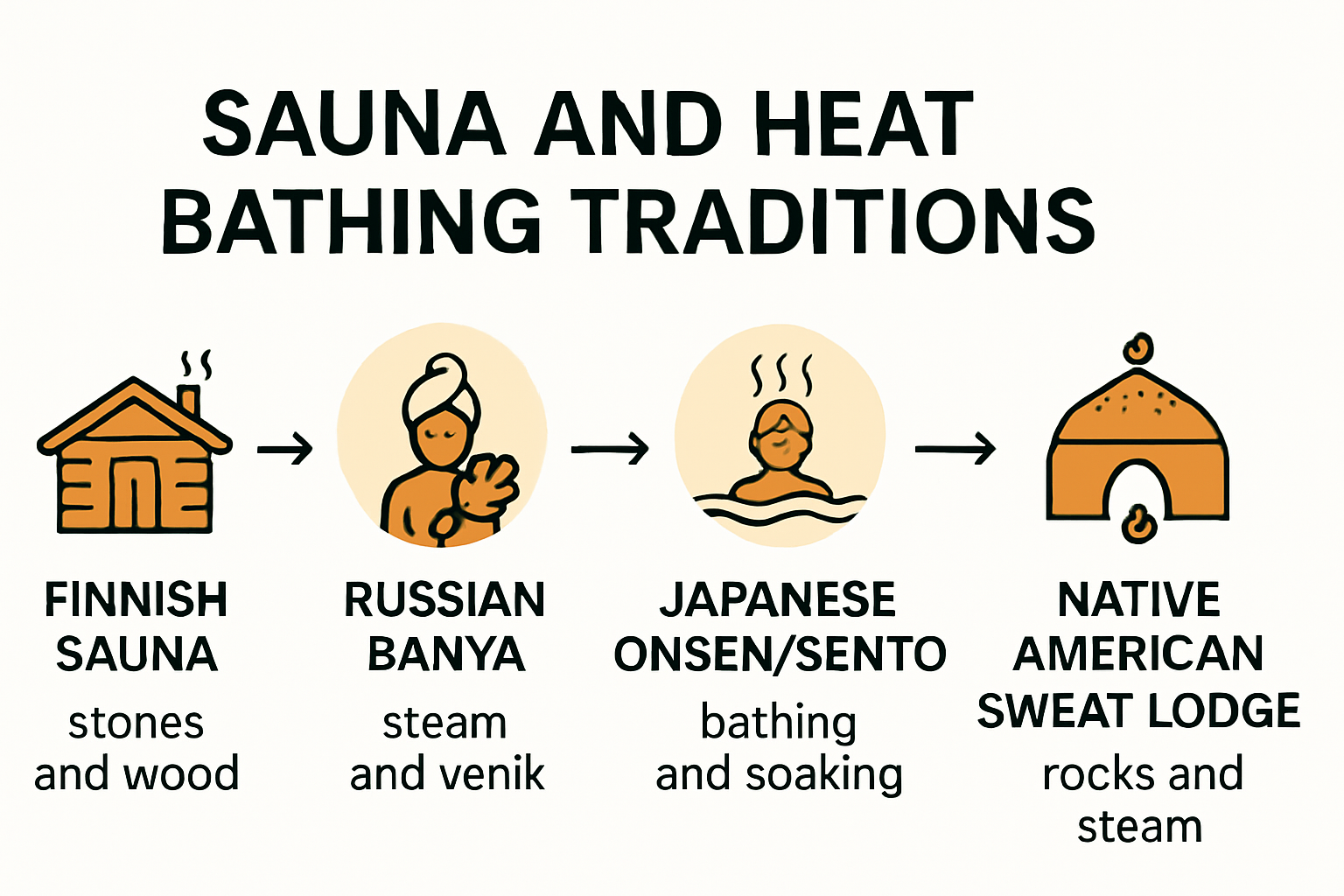
Uncovering Real Historical Sauna Practices (Updated 2025)
 The history of sauna practices is a fascinating journey that reveals deep cultural significance and community bonding. Historical sauna practices reflect the foundations of social interaction, being integral to various civilizations for thousands of years. But hold on. Most people think saunas are just luxury experiences. The truth is far from this misconception. These heat bathing traditions have played crucial roles in physical healing, spiritual rituals, and fostering connections among people throughout history.
The history of sauna practices is a fascinating journey that reveals deep cultural significance and community bonding. Historical sauna practices reflect the foundations of social interaction, being integral to various civilizations for thousands of years. But hold on. Most people think saunas are just luxury experiences. The truth is far from this misconception. These heat bathing traditions have played crucial roles in physical healing, spiritual rituals, and fostering connections among people throughout history.
Table of Contents
Quick Summary
| Takeaway | Explanation |
|---|---|
| Historical sauna practices are deeply cultural | Saunas have been integral to community life, healing, and social interactions across different civilizations for thousands of years. |
| Global variations emphasize communal and spiritual dimensions | Cultures like the Finnish, Turkish, Japanese, and Native American have developed unique sauna and heat bathing traditions that combine physical cleansing with important social and spiritual rituals. |
| Technological advancements have transformed sauna experiences | From primitive heat systems to modern infrared models, sauna technologies have evolved while still serving core human needs for relaxation, connection, and wellness. |
| Saunas serve as multifunctional wellness environments | They are spaces for physical restoration and social bonding, used for various life events in different cultures, highlighting their role in holistic well-being. |
| Contemporary practices reflect ancient wisdom | Modern sauna experiences blend traditional rituals with advanced technology, catering to contemporary lifestyles while preserving their essential purpose for communal heat therapy. |
Origins of ancient sauna traditions
The history of sauna practices extends far beyond modern wellness trends, revealing a rich cultural tapestry of human ingenuity in heat therapy and social connection. Historical sauna practices represent more than just a method of bathing – they were fundamental to community life, healing, and spiritual experiences across diverse civilizations.
Early Prehistoric Heat Bathing Traditions
Archaeological evidence suggests that primitive sauna-like structures date back to approximately 7000 BC during the Mesolithic period. Early humans in Northern European regions, particularly in Finland, began excavating cave-like shelters into natural slopes, creating sophisticated heating systems using stone hearths. These early structures served dual purposes: providing shelter and offering a controlled environment for heat-based purification rituals.
The roots of sauna use can be traced most prominently to Finland, where the tradition stretches back over 2,000 years. Initially, these were simple ground pits carefully heated to high temperatures and covered with branches to retain warmth. Research from the Finnish Sauna Society indicates that these primitive structures were critical not just for physical cleansing, but also for important social and cultural interactions.
Global Variations of Heat Bathing Cultures
While Finnish traditions are most renowned, numerous cultures worldwide developed their own unique heat bathing practices. The Turkish hammam, for instance, represents a thousand-year tradition that transcends mere physical cleansing. These bathhouses were intricate social centers where community members gathered, exchanged information, and maintained complex social rituals.
 Similar heat therapy traditions emerged independently across different continents. In Native American cultures, sweat lodges served as sacred spaces for spiritual purification and healing ceremonies. Indigenous communities in the Americas used these structures not just for physical cleansing, but as profound spiritual experiences that connected individuals with their cultural heritage and natural world.
Similar heat therapy traditions emerged independently across different continents. In Native American cultures, sweat lodges served as sacred spaces for spiritual purification and healing ceremonies. Indigenous communities in the Americas used these structures not just for physical cleansing, but as profound spiritual experiences that connected individuals with their cultural heritage and natural world.
Technological And Cultural Evolution Of Sauna Practices
As civilizations advanced, sauna practices evolved from basic survival mechanisms to sophisticated cultural institutions. The development of more advanced heating technologies, such as wood-burning stoves and precise temperature control methods, transformed these spaces from rudimentary shelters to intentional wellness environments.
Interestingly, the historical sauna practices were never just about heat – they represented complex social systems. In Finnish culture, saunas were spaces of remarkable versatility. They were used for everything from childbirth to preparing bodies for burial, demonstrating the profound cultural significance beyond mere physical cleansing.
Today’s modern sauna experiences, whether in high-end wellness centers or traditional Finnish countryside settings, carry the genetic memory of these ancient practices. They continue to represent not just a method of relaxation, but a deep, culturally embedded approach to human wellness that has survived thousands of years of human civilization.
Sauna rituals around the world
Sauna practices are far more than mere physical experiences – they represent intricate cultural expressions of wellness, social connection, and spiritual transformation across different societies. Sauna culture around the world reveals a fascinating tapestry of human traditions that transcend geographical boundaries and demonstrate remarkable similarities in how diverse cultures approach heat therapy and communal healing.
Nordic and Eastern European Traditions
Finland stands at the epicenter of sauna culture, with practices so deeply embedded that they’ve been recognized by UNESCO as an intangible cultural heritage. The Finnish Sauna Society notes that saunas were not just bathing spaces but sacred environments used for everything from childbirth to preparing bodies for burial. The Finnish sauna ritual typically involves intense heat followed by cooling, often through snow rolling or lake plunging, representing a holistic approach to physical and mental rejuvenation.
In Russia, the banya represents a similar cultural institution. These steam bathhouses are more than just physical cleansing spaces – they’re social hubs where people gather, communicate, and practice traditional healing techniques. Russian banya practices often involve gentle birch branch beating, believed to stimulate circulation and remove negative energy.
Asian Heat Bathing Practices
Japanese culture offers a nuanced approach to communal bathing through onsen and sento traditions. Research from the Japanese Bathing Culture Institute reveals these practices are deeply rooted in spiritual and social contexts. Onsen, typically located near natural hot springs, are not just about physical cleansing but represent moments of profound relaxation and spiritual reconnection.
In Korea, jjimjilbang bathhouses represent another sophisticated heat bathing culture. These multi-level facilities offer various temperature zones, meditation spaces, and communal areas where individuals can socialize, rest, and engage in holistic wellness practices. The Korean bathhouse experience goes beyond simple hygiene, embodying a comprehensive approach to mental and physical restoration.
Middle Eastern and Indigenous Bathing Rituals
The Turkish hammam represents a thousand-year tradition of communal bathing that blends physical purification with social interaction. Historical research indicates these bathhouses were critical community centers where social hierarchies dissolved, and individuals from various backgrounds could interact freely.
Native American sweat lodge ceremonies offer a profoundly spiritual dimension to heat bathing. These rituals, conducted in dome-shaped structures, are not merely physical experiences but sacred ceremonies involving prayer, healing, and community bonding. Each stage of the sweat lodge ceremony carries deep symbolic meaning, connecting participants with ancestral wisdom and natural energies.
 What emerges from these diverse traditions is a universal human impulse: the desire to use heat, steam, and communal spaces as mechanisms for physical healing, social connection, and spiritual transformation. Despite geographical and cultural differences, sauna practices worldwide share a fundamental understanding of human wellness that transcends simple physical cleansing.
What emerges from these diverse traditions is a universal human impulse: the desire to use heat, steam, and communal spaces as mechanisms for physical healing, social connection, and spiritual transformation. Despite geographical and cultural differences, sauna practices worldwide share a fundamental understanding of human wellness that transcends simple physical cleansing.
Saunas evolving through time
The journey of sauna practices represents a remarkable narrative of human adaptation, technological innovation, and cultural preservation. Historical sauna practices have transformed dramatically, reflecting changes in architectural design, heating technologies, and societal understanding of wellness and communal experiences.
Primitive Origins And Medieval Developments
In the earliest stages of human civilization, sauna-like structures were primitive yet ingenious. Archaeological research reveals that initial heat bathing spaces were simple ground pits covered with wood or animal hides, heated using hot stones. These rudimentary structures served multiple purposes: providing warmth, facilitating physical cleansing, and creating spaces for social and spiritual interactions.
During the Middle Ages, sauna designs began to evolve more systematically. Wooden structures replaced ground pits, offering more stable and controlled environments for heat therapy. In Finland, the smoke sauna (savusauna) emerged – a unique design without chimneys where smoke would fill the room before being ventilated, creating a distinctive atmosphere and heating method that remains culturally significant today.
Technological Transformations In Heating
The industrial revolution and subsequent technological advancements dramatically reshaped sauna practices. Research from the International Sauna Association indicates that wood-burning stoves initially dominated, providing consistent heat and allowing for more precise temperature control. Later, electric heaters revolutionized sauna design, making these spaces more accessible and easier to maintain in urban environments.
Modern innovations have introduced diverse heating technologies. Infrared saunas, for instance, represent a significant departure from traditional heat bathing. Unlike conventional saunas that heat the air around the body, infrared models use electromagnetic radiation to directly warm human tissue, offering lower-temperature experiences with potentially different physiological benefits.
Global Diversification And Contemporary Practices
Interestingly, global health studies suggest that despite technological variations, the fundamental human desire for communal heat therapy remains consistent. Whether it’s a traditional Finnish wood-fired sauna, a Japanese onsen, or a modern infrared cabin, these spaces continue to serve core human needs: physical restoration, social connection, and mental relaxation. Consequently, the historical sauna practices around the world represent a fundamental, shared human experience.
The evolution of saunas mirrors broader human technological and cultural progress. From primitive ground pits to sophisticated wellness environments, these spaces have continuously adapted while preserving their essential purpose – creating transformative experiences that connect body, mind, and community. As we look to the future, sauna practices will undoubtedly continue to evolve, reflecting our ongoing quest for holistic well-being and meaningful social interactions.
Frequently Asked Questions
What are the origins of sauna practices?
Sauna practices trace back to approximately 7000 BC with primitive structures in Northern Europe, especially Finland, where early humans used heated caves for purification rituals and community bonding.
How have sauna practices evolved over time?
Sauna practices have evolved from simple heat bathing into complex cultural rituals, incorporating advanced heating technologies and serving diverse functions, from childbirth to spiritual ceremonies across various cultures.
What are some global variations of sauna rituals?
Different cultures have unique sauna rituals, such as the Finnish sauna, Turkish hammam, Japanese onsen, and Native American sweat lodges, each emphasizing communal and spiritual dimensions of heat therapy.
What modern technologies are used in saunas today?
Modern saunas utilize various technologies like wood-burning stoves, electric heaters, and infrared systems, each offering distinct experiences and health benefits, adapting ancient practices to contemporary lifestyles.
Embrace the Age-Old Tradition of Sauna for Modern Wellness
Imagine immersing yourself in a practice that has stood the test of time, with roots tracing back to ancient civilizations that esteemed sauna rituals not just for their physical benefits, but for their profound ability to foster community and spiritual connection. At Best Life Sauna, we understand that today’s fast-paced lifestyle can disconnect us from these essential wellness practices, leaving many individuals yearning for genuine relaxation and connection.

By incorporating sauna use into your daily routine, you can tap into health benefits such as:
- Stress relief
- Improved blood circulation
- Enhanced skin health
Don’t let the hustle and bustle of life drown out the ancient wisdom of wellness. Explore our diverse selection of premium saunas, including infrared, traditional, and outdoor options, designed to meet your unique needs. Plus, enjoy free shipping on orders over $200 and our price match guarantee. Visit us today at Best Life Sauna, and start your journey towards a more rejuvenated, connected, and healthier you – because the time for holistic wellness is now!
Recommended Articles
- 2025 Aesthetic Sauna Designs: Stunning Ideas & Trends – Best Life Sauna
- Why a Sauna Makes the Perfect Christmas Gift That Keeps on Giving All – Best Life SaunaBest Life Sauna - Premium Saunas for WellnessAmerican ExpressApple PayDiners ClubDiscoverGoogle PayMastercardPayPalShop PayVisa
- Unlocking the Health Benefits of Saunas – Best Life SaunaBest Life Sauna - Premium Saunas for WellnessAmerican ExpressApple PayDiners ClubDiscoverGoogle PayMastercardPayPalShop PayVisa
- 2025 Sauna Technology Innovations: New Era for Wellness – Best Life Sauna
- 2025 Sauna Innovations in Wellness: Future Trends & Benefits – Best Life Sauna

